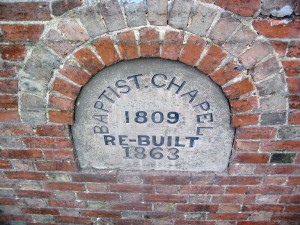Baptist History in Swanbourne
A Short History on Baptist activity in Swanbourne
By Ken Harris
Baptists are people who mark themselves out from other Christians through their practice of insisting on adult baptism, rather than allowing or recognising paedobaptism – i.e. the baptism of infants. The first known Baptist congregation in England date back to 1608, when people fleeing from the Netherlands came together in London. The earliest named Baptist in this area was Benjamin Keach of Winslow (1640 – 1704). He was a baptist minister in Winslow before moving to London in 1668. Keach’s chapel in Winslow, built in 1695, is still standing, though no longer in regular use.
Archbishop Sheldon’s return of 1669 on non-conformists records in Swanbourne that ‘At the house of George Deverell Yeoman; not above 20 mean people; taught be William Giles, a shopkeeper and Hartnoll a Thatcher. The latter was the well-known leading Baptist of North Bucks whose home was at North Marston.’
At the Quarter Sessions held on 27th April 1704, Matthew Leno’s House was registered for worship, and the Swanbourne Parish Church register records that on January 11th 1724 (1725 in modern dating), Jane Webb alias Leno, an old woman Anabaptist, was buried without ye service.
On 11th April 1809, the first Baptist Chapel in Swanbourne was opened. It must have been small, because the launch meeting was held in Winslow in order to accommodate the congregation and 3 ministers who were present. On the same day, William Collett of Dinton was ordained as Pastor over the church, and Daniel Walker was ordained as Deacon. Mr Clement of Tring, Mr Williams of Waddesdon and Mr Clarke of Ivinghoe ‘performed the business of the day.’
It is recorded that Mr Collett ‘laboured with considerable success and Mursley, Drayton and Newton became branches of this Church, which at the death of Mr Collet, which took place April 25th 1826, had increased to seventy members.’
In 1829, the vicar reported that the Anabaptist meeting had 70 Anabaptists and also about 70 Methodists, but “There are many church going people who sometimes go to the meeting when there is no service in the afternoon or morning at church.”
In the religious census, taken on 30th March 1851, the return for the Baptists was given by John Dumbleton, Minster of Winslow. The congregation in the morning March was given as 42 with 6 Sunday Scholars, in the afternoon, 72 and in the evening 72. The average morning congregations were given as 75. The chapel would seem to have had accommodation for 143 people, with 27 free sittings accommodating 126 people and 3 other sittings, accommodating 17 people.
This chapel was eventually replaced by a larger building in 1863, which continued to provide a place for worship for over 100 years. However, it eventually closed down in 1969, and is now a home, going by the name of Whittlewood House.


